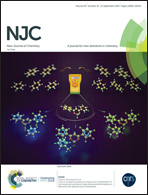Tuning the morphology of the active layer of organic solar cells by spin 1/2 radicals†
Abstract
The morphology of the active layer, the formation of an interpenetrating network structure and the phase separation of donor–acceptor polymers play critical roles in determining the performance of organic solar cells, and are often difficult to control in a rational manner. Herein, an effective approach for tuning the morphology of the active layer by adding fluorinated polymers and the spin 1/2 radical galvinoxyl into the active layer is reported. Advanced scattering techniques, grazing-incidence small- and wide-angle X-ray scattering, are used to observe the morphological changes of the films. The apparent ordered structure is increased, and an improved film with a smaller domain size is obtained after the addition of the spin 1/2 radical. The highest power conversion efficiency of solar cells is improved by 79%. The efficiency increase is attributable to the better dispersion of the donor and acceptor units in the active layer, the improvement of the smoother morphology and the interpenetrating network structure after the addition of spin 1/2 radical galvinoxyl. Thus, research on tuning the film morphology of solar cell devices has far-reaching significance for the study of solar cell performance in the future.



 Please wait while we load your content...
Please wait while we load your content...